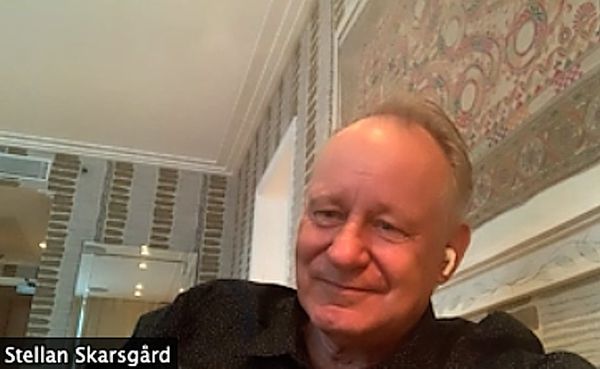 |
| Stellan Skarsgård on Maria Sødahl’s Oscar shortlisted Hope (Håp): “Many directors just put the camera on the person talking but she records the reactions from every character in the film.” |
Stellan Skarsgård starred in Hans Petter Moland’s Out Stealing Horses, In Order Of Disappearance, A Somewhat Gentle Man, Zero Kelvin, and Aberdeen. When he was approached to portray Tomas, a rendition of Moland, in Maria Sødahl’s stunning piece of auto-fiction, Hope (Håp), Stellan told me: “When I first considered I’m actually going to play one of my best friends, I was thinking, but I cannot imitate him … But then of course I just cut loose and did the material from the script."
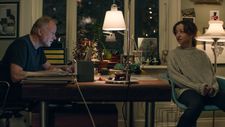 |
| Tomas (Stellan Skarsgård) with Anja (Andrea Bræin Hovig) in Hope (Håp) Photo: Manuel Alberto Claro |
In Hope, Anja (Andrea Bræin Hovig) returning home to Oslo from directing a successful stage production abroad, is greeted by her youngest child, 10-year-old Isak (Daniel Storm Forthun Sandbye), on the staircase of their building. She lives with her partner Tomas (Stellan Skarsgård), their three children together, Julie (Elli Rhiannon Müller Osbourne), Simon (Steinar Klouman Hallert), and Isak, plus Henrik (Eirik Hallert), Ada (Dina Enoksen Elvehaug), and Erlend (Alfred Vatne), the three children he had with his ex-wife. Christmas is fast approaching, Anja’s father (Einar Økland) is visiting and she isn’t feeling very well with terrible headaches that almost blind her.
Instead of being based on a true story or inspired by actual events, the notation at the start of Hope states: “This is my story as I remember it.” These words make a much more personal claim and at the same time tell us that memory always includes the question of perspective. Maria Sødahl’s Oscar-shortlisted Hope is structured around seemingly small jolts that suddenly illuminate the big picture.
Stellan Skarsgård, the anchor of the film, is masterful at reacting. His “reactor” stays close to us in revelations and realisations, while we discover with him what Anja has been feeling and dreading for quite some time.
![Stellan Skarsgård on the Hope family: “[It] so much resembled in many ways my family and with all the kids and the big apartment and with all of this life …”](/images/newsite/Hope_family_225.jpg) |
| Stellan Skarsgård on the Hope family: “[It] so much resembled in many ways my family and with all the kids and the big apartment and with all of this life …” Photo: Manuel Alberto Claro |
From London, Stellan Skarsgård joined me on Zoom for a conversation on Hope.
Anne-Katrin Titze: Hello Stellan! Greetings from New York. Where are you?
Stellan Skarsgård: I’m in London! I’m in a hotel room in London.
AKT: How are you this morning?
SS: I’m good, it’s not morning for me anymore.
AKT: Of course, how silly of me.
SS: I’m very good. I’ve been out to the studio to do some tests today only. I haven’t shot today. But I’m really tired of hotel rooms.
AKT: I am very happy that Hope is shortlisted for the Oscars. I’m crossing my fingers. Stellan, you were the first one on Zoom, so let me start with you. [We were then joined by Maria Sødahl and Andrea Bræin Hovig] You made films with the man [Hans Petter Moland] whom you are playing in Hope. Did you feel protective of him while playing? Did you protect him from yourself?
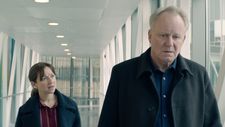 |
| Tomas (Stellan Skarsgård) with Anja (Andrea Bræin Hovig): “He doesn’t say much and she is full-on. She is running the show.” Photo: Manuel Alberto Claro |
SS: I don’t know. When I first considered I’m actually going to play one of my best friends, I was thinking, but I cannot imitate him, because if I imitated him, it would be so slow, the movie. Because he speaks so slowly and thinks so much. So I couldn’t do it his way, I had to spare the audience that. But then of course I just cut loose and did the material from the script and didn’t care about him very much when I was doing it. He was a little afraid - “what will be my reputation after this film?” he said. And then I said it would be better.
AKT: You don’t lack self-esteem. The moment when I knew that I was watching not only a good film but a really great film was the scene of revelation by the doctor that the lung cancer can spread to the brain and [Tomas and Anja’s] reactions. Your reaction at that moment is a jolt, sitting next to Anja who is calm because she is more expecting what is coming. You are reacting as if thunder and lightning are coming through you. Your whole body is revolting against the revelation. You know the moment I mean?
SS: Yeah, I know the moment. It’s interesting with the two different reactions. Because the husband that I’m playing, he takes it directly and physically while Anja has a totally different reaction.
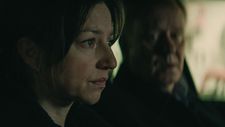 |
| Tomas (Stellan Skarsgård) with Anja (Andrea Bræin Hovig): “You know that the only time that you have a chance to talk is when you’re alone in a car.” Photo: Manuel Alberto Claro |
AKT: The exchange in front of the priest is also very impressive.
“We haven’t lived the same life,” says Anja when Tomas complains that her description of their history to a priest sounded “shabby.”
SS: Yeah, I mean, when things go bad for you, your reaction is to react aggressively against someone whose fault it is, whether it’s their fault or not. But your body says: react!
AKT: The story of remarriage in Hope is so interestingly told. There are many classic fairy tales, mainly French ones, where the plot begins with the wife dying and telling her husband “I want you to marry only someone who is as beautiful and as smart as I am.” And then come the regrets. Especially the scenes with Vera [Gjertrud L Jynge] reminded me of that. Your reactions at the dinner table, the proposal.
SS: My position as the role is of course that she [Anja] comes up with the most crazy ideas all the time. So remarrying to me is not a very practical idea. I’m trying to make things work. And she wants to have a wedding party in the middle of this shit. So whatever she desires I will try to provide. But it’s not until the actual moment in the church that he thinks this was a good idea.
 |
| Hope (Håp) director Maria Sødahl with Andrea Bræin Hovig in Oslo |
AKT: The actual wedding was filmed without sound. It feels as though we are underwater with them. The cinematography adds to that. I think you worked with the cinematographer [Manuel Alberto Claro] on Melancholia? He does a fantastic job here.
SS: Yeah, and Maria worked with him before on her first film [Limbo].
AKT: [Maria] mentioned time standing still in the car and in the bedroom. I don’t know about the bedroom but for the car - Abbas Kiarostami also pointed out something about time standing still in the car. He has a lot of car scenes in his films and it is interesting how the movement from one place to another, that’s when we realize time taking place.
SS: It’s also like, Maria’s family has six kids, I have eight kids, Andrea has several kids - you know that the only time that you have a chance to talk is when you’re alone in a car.
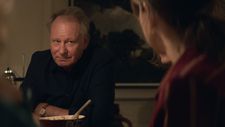 |
| Stellan Skarsgård on Tomas with Anja (Andrea Bræin Hovig): “My position as the role is of course that she comes up with the most crazy ideas all the time.” Photo: Manuel Alberto Claro |
AKT: There’s the practical answer to my metaphysical setup! Any comment about acting opposite real doctors and health professionals in Hope?
SS: Film I think is very different from stage acting. Stage acting is so much technique to make it even visible twenty meters away or audible twenty meters away. Also on stage you are in the same room as the audience which means it is real, even if it’s stylized, even if it’s a heightened reality. But on film, the camera is so revealing. It tells if you’re just relying on your tools. It can tell immediately that you’re lying. That’s why sometimes amateurs are brilliant in front of the camera.
I mean, when Björk won the prize in Cannes as best actress [for Dancer In The Dark], she’s never acted before. But her presence in front of the camera was so vivid. And those actors, or rather doctors, we had here, they knew exactly what they were doing. They were not trying to portray anything. They weren’t trying to do anything strange or displaying a whole character in many dimensions. They were doing what they were doing every day. And they were alive in front of the camera and it was fantastic to see. And they’re all different. Different characters that sort of stand out. Beautiful.
AKT: I loved your reactions to the doctors, to the pharmacist. In my review I call you the great reactor. You are anchoring us because Anja knows what she is going through while Tomas is a little closer to us as the audience. Through his reactions we are entering this family.
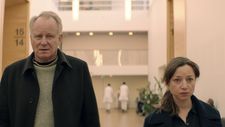 |
| For Tomas (Stellan Skarsgård) and Anja (Andrea Bræin Hovig) when the worst is confirmed, nothing in their world stays the same. Photo: Manuel Alberto Claro |
SS: Yes. I’m happy that that’s the result. I mean, he doesn’t say much and she is full-on. She is running the show. As in real life, you feel … Because my wife had cancer and I remember the helpless feeling you have and also that you cannot compete with a cancer. The cancer is her new lover in a way. And you’re just trying to make sure that things work. And try to mitigate the results of this horrible situation.
So I could absolutely identify but the important thing is that what Maria does is that she gives me a role that doesn’t say much and doesn’t do much and that is helpless. But she records him. Many directors just put the camera on the person talking but she records the reactions from every character in the film. If you look even at the children, even if they’re just on screen for seconds now and then, they’re all full human beings because Maria has been interested in everybody and in their relations and in their reactions.
AKT: That is exactly how it felt. This is how it came across. It is not just about the person talking - that’s why I prefer the gallery view on Zoom to the speaker view. I like watching the reactions as well. I love what [Maria] said, that each movie needs one false scene or one wrong thing.
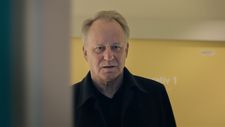 |
| Stellan Skarsgård: “Film I think is very different from stage acting.” Photo: Manuel Alberto Claro |
It makes me think of a conversation I had with Ann Roth, who is one of my all-time favourite costume designers who did everything from The English Patient to Midnight Cowboy. Her mantra is to always add something that is off in what characters are wearing. Something that is wrong for them. And I love that. Same for artworks. We always need the small thing that disturbs us.
SS: I think that goes for all art. Art that is perfect is dead usually. Because life is never perfect. It’s the flaws that bring things to life.
AKT: I totally agree. Did this very profound work of art that you are part of, did it shift anything about your ideas of death?
SS: Well, I thought about death when I was three years old and realised that I had to deal with it. And I haven’t thought about it since. Because I was fine with it. I can’t say that this project taught me more about death. But it reminded me of life and the importance of life. And even the family that we had in this film, which so much resembled in many ways my family and with all the kids and the big apartment and with all of this life - it emphasised the thing that I already knew.
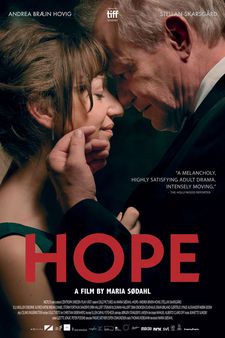 |
| Hope poster |
That this was the most important thing in my life and that work or career or all the other superficial things were not that important. I mean it’s always been important to me. I work four months a year and I’m changing diapers and cooking the other eight months of the year. But I really experienced in a strange way as an actor the very essence of what is important in my life.
AKT: What do you cook?
SS: Everything! What do you want?
AKT: Something vegetarian?
SS: I have vegetables sometimes on the plate too, yes.
- Andrea Bræin Hovig on working with Maria Sødahl and Stellan Skarsgård on Hope (Håp).
- Maria Sødahl on bringing Hope to the screen.





















